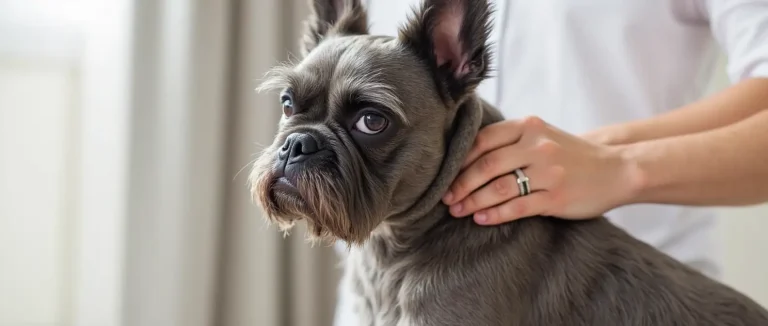White French Bulldog: 7 Tips for Finding Your Perfect Furry Friend
Looking for a white French bulldog? Get top tips to find your ideal companion, ensuring a perfect match. Discover essential advice today!
Introduction
The white French Bulldog—a compact bundle of joy wrapped in a creamy coat with an irresistible personality. These charming companions have skyrocketed in popularity, becoming one of the most sought-after color variations of the beloved Frenchie breed. With their distinctive bat-like ears, muscular build, and that unmistakable snowy coat, white French Bulldogs stand out in the canine world as both fashionable pets and devoted family members.
Understanding what makes these pale-coated pups unique is crucial before bringing one home. From health considerations specific to their coloration to finding reputable breeders who prioritize welfare over trendy aesthetics, the journey to finding your perfect white French Bulldog companion requires knowledge and careful consideration.
Did you know that true white French Bulldogs are relatively rare? Many “white” Frenchies actually have cream or light fawn undertones, and the quest for the perfect snow-white specimen has led to some controversial breeding practices. This fascinating color variation comes with its own set of considerations that every potential owner should understand before falling in love with those soulful eyes and adorable snorts.
Species Overview
Scientific Name: Canis lupus familiaris
The French Bulldog, including the white variety, belongs to the same species as all domestic dogs. Though they may look distinctly different from a German Shepherd or a Chihuahua, they share the same scientific classification.
Physical Characteristics
White French Bulldogs typically stand 11-12 inches tall at the shoulder and weigh between 16-28 pounds, with males generally being slightly larger than females. Their most striking feature is, of course, their pure white coat, which should be short, smooth, and glossy. The breed standard accepts white as an official color, though it’s important to note that not all white Frenchies are completely white—some may have subtle cream markings.
These compact dogs sport the characteristic “bat ears” that stand erect, giving them an alert, curious expression. Their faces feature the distinctive brachycephalic (flat-faced) structure with adorable wrinkles, a short snout, and often a slightly undershot jaw. They have muscular, compact bodies with broad chests and sturdy legs that belie their small stature.
Subspecies
While not technically subspecies, French Bulldogs come in several color variations beyond white, including fawn, brindle, cream, and combinations with various markings. Within the white category, you’ll find pure white French Bulldogs and those with minimal markings. The American Kennel Club recognizes white as a standard color, though some white French Bulldogs with excessive spotting or patches may not meet show standards.
It’s worth noting that true albino French Bulldogs are extremely rare and should not be confused with white Frenchies, as albinism is a genetic condition affecting pigmentation throughout the body, including the eyes and skin.
Habitat and Distribution
Natural Habitat
Unlike their wild ancestors, white French Bulldogs are thoroughly domesticated companions who thrive in human homes. They’re especially well-suited to apartment living due to their small size and relatively low exercise requirements. These adaptable pups prefer indoor environments where temperatures remain moderate—their brachycephalic structure makes them sensitive to extreme heat, while their short coats provide limited protection from cold.
Geographic Range
Originally developed in England before finding popularity in France (hence their somewhat misleading name), French Bulldogs have now spread worldwide. The white French Bulldog can be found across North America, Europe, Australia, and increasingly in Asian countries like Japan and China, where their distinctive looks and apartment-friendly size make them ideal urban companions.
Adaptations
White French Bulldogs have adapted beautifully to life as human companions. Their compact size makes them perfect for city living, while their generally calm demeanor (punctuated by playful bursts of energy) suits various household dynamics. However, their physical structure represents adaptations driven by human preferences rather than natural selection.
Their brachycephalic faces, while adorable, can lead to breathing difficulties, especially in hot or humid conditions. Their stocky bodies and relatively short legs limit their swimming ability, making supervision around water essential. Perhaps most notably, their body structure typically prevents natural breeding, with most Frenchie litters delivered via artificial insemination and often cesarean section—an adaptation to human-directed breeding rather than environmental conditions.
Diet and Feeding Habits

What It Eats
In their domesticated environment, white French Bulldogs thrive on high-quality commercial dog food formulated for small to medium breeds with moderate energy needs. The ideal diet should be appropriate to their age (puppy, adult, senior) and contain a balanced blend of proteins, fats, carbohydrates, vitamins, and minerals.
Many white French Bulldog owners opt for kibble specifically designed for brachycephalic breeds, which features smaller pieces that are easier to pick up and chew with their unique jaw structure. Some owners supplement commercial diets with safe fresh foods like lean proteins, certain fruits, and vegetables, though always in moderation and after consulting with a veterinarian.
Hunting or Foraging Behavior
Unlike their wolf ancestors, white French Bulldogs don’t hunt or forage in the traditional sense. However, they retain some instinctual behaviors—many enjoy puzzle toys that simulate “working” for food, which engages their brain and satisfies natural instincts. When given appropriate toys, they may display digging or “hunting” behaviors, pouncing on and shaking plush toys.
Despite their sometimes lazy reputation, mealtime often reveals surprising energy and enthusiasm. Many French Bulldogs become quite animated at feeding time, sometimes performing excited “dances” or vocalizing their impatience.
Dietary Needs
White French Bulldogs have specific dietary considerations beyond basic nutrition. Their sensitive digestive systems often require foods that minimize gas and bloating—common issues in the breed. Their flat faces can make eating challenging, so properly sized kibble or appropriately served wet food helps prevent choking and ensures comfortable mealtimes.
Because the breed tends toward obesity, portion control is essential. A white French Bulldog’s diet should be carefully measured, with treats comprising no more than 10% of daily caloric intake. Some Frenchies have food allergies that manifest in skin issues—particularly noticeable on their white coats—so monitoring for potential food sensitivities is important for maintaining their health and comfort.
Behavior and Social Structure
Social Behavior
White French Bulldogs are profoundly social creatures that thrive on human interaction. These dogs form deep bonds with their families and often develop a particularly strong attachment to one person, though they typically shower affection on everyone in the household. Despite their sometimes stubborn streak, they’re known for their desire to please, making them generally agreeable companions.
While they don’t require excessive exercise, white French Bulldogs enjoy regular play sessions and short walks. Their playful nature often continues well into adulthood, with many Frenchies retaining puppy-like enthusiasm throughout their lives. They typically get along well with other pets when properly socialized, though some may exhibit stubbornness or resource guarding that requires consistent training.
Communication
White French Bulldogs are expressive communicators despite not being particularly vocal. While they aren’t known for excessive barking, they’ve developed a remarkable repertoire of sounds—from grunts and snorts to peculiar “yodels” and expressive whines—that owners quickly learn to interpret.
Their bodies speak volumes: the characteristic Frenchie “hop” when excited, play bows to initiate games, and dramatic flopping onto their backs for belly rubs are all part of their physical vocabulary. Their facial expressions, particularly through their expressive eyes and tilting heads, communicate curiosity, confusion, or delight with remarkable clarity.
Many white French Bulldogs become adept at using their paws to communicate, gently tapping their owners for attention or strategically placing themselves in the path of someone heading to the kitchen or door.
Mating and Reproduction
The mating process for white French Bulldogs typically requires human assistance. Due to their body structure—narrow hips and broad shoulders—natural breeding is difficult and sometimes dangerous. Most responsible breeding involves artificial insemination, and approximately 80% of French Bulldog births occur via cesarean section.
Female Frenchies typically have smaller litters compared to many dog breeds, averaging 3-4 puppies. White French Bulldog puppies are particularly delicate at birth and require attentive care from both mother and breeder. While white coloration is a recessive gene, breeding specifically for white coats requires genetic understanding to avoid health issues sometimes associated with color-focused breeding.
The average lifespan of a healthy white French Bulldog ranges from 10-12 years, though some live longer with excellent care. Sexual maturity is typically reached between 6-9 months, though responsible breeders wait until dogs are fully mature (around 2 years) before breeding to ensure proper development.
Conservation Status
Endangerment Level
As domesticated companions rather than wild animals, white French Bulldogs aren’t evaluated by traditional conservation metrics like the IUCN Red List. However, their popularity presents its own challenges to the health and welfare of the breed.
Threats
The greatest threats facing white French Bulldogs stem from irresponsible breeding practices. The surge in demand for these distinctive dogs has led to problematic breeding focused on appearance rather than health, exaggerating already challenging physical traits like extremely flat faces that worsen breathing difficulties.
White French Bulldogs face specific health challenges related to their coloration. White coats are sometimes (though not always) associated with congenital deafness, particularly when linked to the extreme piebald gene. Additionally, their pale skin is more susceptible to sunburn and potentially skin cancers without proper protection.
The breed’s popularity has also led to significant price inflation, creating a market for puppy mills and unethical breeders who prioritize profit over welfare, potentially passing genetic health issues to future generations.
Conservation Efforts
While not conservation in the traditional sense, efforts to protect the French Bulldog breed’s health are underway through responsible breeding initiatives. Organizations like the French Bulldog Club of America promote ethical breeding practices that prioritize health testing, genetic diversity, and temperament over extreme physical features.
Some breeders are working toward “healthier Frenchies” by selectively breeding for slightly longer muzzles to improve breathing without losing the breed’s distinctive appearance. Advocate groups also educate potential owners about the importance of supporting ethical breeders rather than purchasing from puppy mills or backyard breeders.
Responsible ownership education represents another form of “conservation,” ensuring these beloved companions receive appropriate care throughout their lives rather than being surrendered when owners discover the realities of the breed’s health needs and care requirements.
Interesting Facts
• White French Bulldogs appear in the historical records of European nobility, with Queen Victoria owning several Frenchies, including white ones, contributing to their fashionable status.
• The distinctive “bat ears” that define today’s French Bulldogs weren’t always the standard—early French Bulldogs often had “rose ears” similar to English Bulldogs until American fanciers established the bat ear as the preferred type.
• Despite their name suggesting French origin, these dogs were initially bred in England by lace workers who brought their small bulldogs to France during the Industrial Revolution.
• White French Bulldogs cannot regulate their body temperature efficiently, making them one of the few dog breeds that may need air conditioning in summer and sweaters in winter.
• Their unique vocalization abilities have made Frenchies social media stars, with some white French Bulldogs amassing millions of followers through their expressive “talking.”
• While they don’t excel at traditional dog sports like agility due to their physical limitations, French Bulldogs often perform surprisingly well in nose work and scent detection activities.
• The French Bulldog was the passenger of choice aboard the ill-fated Titanic for some wealthy travelers, with several Frenchies documented on the ship’s manifest. One white Frenchie named Gamin de Pycombe was insured for the modern equivalent of $20,000.
7 Tips for Caring for Your White French Bulldog
1. Protect Their Sensitive Skin and Coat
White French Bulldogs have particularly sensitive skin that requires special attention. Use dog-specific sunscreen on exposed areas when outdoors to prevent painful burns. Their white coats show staining easily, so regular bathing with gentle, whitening shampoos designed for dogs helps maintain their pristine appearance. Daily cleaning of facial wrinkles with unscented baby wipes or specialized wrinkle wipes prevents irritation, infection, and the reddish-brown staining that’s particularly visible on white coats.
2. Manage Temperature Extremes Carefully
Due to their brachycephalic structure, white French Bulldogs struggle to regulate body temperature. Never leave your Frenchie outdoors in temperatures above 75°F (24°C) without shade and water. Consider cooling vests for summer walks, schedule exercise for cooler mornings or evenings, and invest in cooling mats for hot days. In winter, provide sweaters for outdoor activities as their short coats offer minimal protection against cold.
3. Commit to Specialized Veterinary Care
White French Bulldogs benefit from veterinarians familiar with brachycephalic breeds. Schedule regular check-ups with emphasis on respiratory health, skin conditions, and ear examinations. Consider pet insurance that covers breed-specific issues like BOAS (Brachycephalic Obstructive Airway Syndrome) surgery, spinal problems, and allergies. Establish baseline hearing tests early, as white coat coloration occasionally correlates with hearing impairments.
4. Feed an Appropriate Diet
Provide high-quality food formulated for small breeds with moderate energy needs and potential food sensitivities. Consider kibble shapes designed for brachycephalic dogs to facilitate easier eating. Use raised food dishes to reduce strain on their neck and potentially minimize gas. Monitor weight closely, as obesity severely compounds breathing difficulties and joint problems common in the breed.
5. Implement Strategic Exercise Routines
Design exercise regimens that build strength without taxing breathing. Short, multiple walks are preferable to single long excursions. Swimming under close supervision (with a doggy life jacket) offers excellent low-impact exercise. Puzzle toys provide mental stimulation without physical exertion during extreme weather conditions when outdoor activities must be limited.
6. Create a Frenchie-Friendly Home Environment
Provide steps or ramps to favorite furniture to protect their backs, as French Bulldogs’ structure makes them prone to intervertebral disc disease. Install air purifiers to ease breathing for this respiratory-sensitive breed. Consider wood or tile flooring in at least some areas, as these surfaces naturally stay cooler and provide relief during warmer weather.
7. Prioritize Socialization and Mental Stimulation
Despite their physical limitations, white French Bulldogs need mental engagement. Enroll in positive-reinforcement training classes that accommodate brachycephalic breeds with shorter sessions and climate-controlled environments. Arrange “Frenchie playdates” with compatible dogs for social development. Rotate toys regularly to prevent boredom, focusing on puzzle toys that dispense treats or hide-and-seek toys that engage their surprisingly keen sense of smell.
Role in the Ecosystem
Ecological Importance
As fully domesticated companion animals, white French Bulldogs don’t play a natural role in wild ecosystems. Their importance lies primarily in their human-animal bond and the social-emotional benefits they provide to their owners. Studies have shown that companion animals like French Bulldogs can lower blood pressure, reduce stress hormones, and increase beneficial hormones like oxytocin in their human companions.
In urban environments, responsible dog ownership contributes to community building, with dog walking facilitating social interactions between neighbors who might otherwise remain strangers. The unique appearance of white French Bulldogs often serves as conversation starters, creating connections between diverse individuals.
Impact of Decline
While not ecologically significant in the wild, any potential decline in healthy French Bulldog populations would represent a cultural and emotional loss. The breed’s distinctive appearance and personality have made it a beloved companion for over a century, and its presence in art, literature, and media reflects its cultural significance.
More concerning than population decline is the trend toward extreme physical features that compromise health. The greatest threat to French Bulldogs is not extinction but rather the perpetuation of physical traits that cause suffering. Efforts to breed healthier French Bulldogs with slightly longer muzzles, wider nostrils, and better temperature regulation would help ensure these beloved companions can continue bringing joy without unnecessary health struggles.
Conclusion
The white French Bulldog represents a fascinating blend of human influence and canine adaptability. With their striking appearance, charming personality, and devoted nature, it’s no wonder these distinctive dogs have captured hearts worldwide. Finding your perfect white French Bulldog companion requires understanding both the joys and challenges of this unique breed.
By prioritizing ethical breeding practices and responsible ownership, you can help ensure these beloved companions thrive for generations to come. Whether you’re drawn to their snow-white coats, expressive eyes, or clownish personalities, a well-researched approach to finding your white French Bulldog will lead to a rewarding relationship built on mutual care and understanding.
If you’re considering adding a white French Bulldog to your family, remember that the healthiest choice is often not the most extreme in appearance. Support breeders who prioritize health testing, genetic diversity, and moderate physical features that allow these dogs to breathe, move, and live comfortably. By making informed choices, you contribute to a brighter future for these extraordinary companions while gaining a loyal friend who will bring immeasurable joy to your life.
Frequently Asked Questions
How much does a white French Bulldog typically cost?
White French Bulldogs generally range from $3,000 to $7,000 from reputable breeders, with prices sometimes exceeding $10,000 for dogs with exceptional lineage or rare platinum white coloration. This higher price point (compared to other colors) reflects both their popularity and the additional health testing responsible breeders conduct for white dogs. Be wary of significantly lower prices, as they often indicate puppy mills or breeders who skip crucial health screenings.
Are white French Bulldogs more prone to health problems than other colors?
White French Bulldogs share the same general health concerns as all Frenchies (respiratory, spinal, and joint issues), but their coloration brings some additional considerations. They may have higher rates of congenital deafness, particularly those with piebald gene markers. Their pale skin is more susceptible to sunburn and related skin conditions. However, a white Frenchie from health-tested parents can be just as healthy as any other color variant.
How can I tell if a white French Bulldog breeder is reputable?
Reputable white French Bulldog breeders will provide health clearances for both parent dogs (including BAER hearing tests, patella evaluations, and DNA tests for hereditary conditions). They’ll welcome home visits, have limited litters per year, offer health guarantees, and ask you as many questions as you ask them. They’ll show genuine concern for puppy placement rather than simply accepting payment, and they’ll provide ongoing support throughout your dog’s life.
Do white French Bulldogs require special grooming?
Yes, white French Bulldogs need some special grooming considerations. Their white coats show dirt and tear stains more visibly, requiring more frequent cleaning with appropriate whitening shampoos. Their facial wrinkles need daily cleaning to prevent the reddish-brown staining particularly noticeable on white fur. Their sensitive skin also benefits from gentle, hypoallergenic products and may require dog-safe sunscreen on exposed areas when outdoors.
Can white French Bulldogs safely participate in dog sports or activities?
While white French Bulldogs can’t safely participate in high-intensity activities due to their breathing limitations, they can enjoy modified versions of many dog sports. They often excel at rally obedience, nosework, and trick training. Swimming (with proper supervision and life vests) provides excellent low-impact exercise. The key is choosing activities that don’t tax their respiratory system and scheduling any physical exertion during cooler parts of the day.







